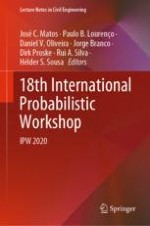2021 | OriginalPaper | Chapter
A Quick Criterion for Calculating Waiting Phenomena at Intersections
Authors : Raffaele Mauro, Marco Guerrieri, Andrea Pompigna
Published in: 18th International Probabilistic Workshop
Publisher: Springer International Publishing
Activate our intelligent search to find suitable subject content or patents.
Select sections of text to find matching patents with Artificial Intelligence. powered by
Select sections of text to find additional relevant content using AI-assisted search. powered by
